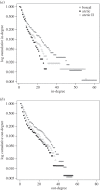Climate change alters the structure of arctic marine food webs due to poleward shifts of boreal generalists
- PMID: 26336179
- PMCID: PMC4571709
- DOI: 10.1098/rspb.2015.1546
Climate change alters the structure of arctic marine food webs due to poleward shifts of boreal generalists
Abstract
Climate-driven poleward shifts, leading to changes in species composition and relative abundances, have been recently documented in the Arctic. Among the fastest moving species are boreal generalist fish which are expected to affect arctic marine food web structure and ecosystem functioning substantially. Here, we address structural changes at the food web level induced by poleward shifts via topological network analysis of highly resolved boreal and arctic food webs of the Barents Sea. We detected considerable differences in structural properties and link configuration between the boreal and the arctic food webs, the latter being more modular and less connected. We found that a main characteristic of the boreal fish moving poleward into the arctic region of the Barents Sea is high generalism, a property that increases connectance and reduces modularity in the arctic marine food web. Our results reveal that habitats form natural boundaries for food web modules, and that generalists play an important functional role in coupling pelagic and benthic modules. We posit that these habitat couplers have the potential to promote the transfer of energy and matter between habitats, but also the spread of pertubations, thereby changing arctic marine food web structure considerably with implications for ecosystem dynamics and functioning.
Keywords: biogeography; climate warming; fish community; food web topology; modularity; network structure.
© 2015 The Authors.
Figures




Comment in
-
Climate change: A rewired food web.Nature. 2015 Nov 12;527(7577):173-4. doi: 10.1038/nature16311. Epub 2015 Nov 4. Nature. 2015. PMID: 26536113 No abstract available.
References
-
- Overland JE, Wang M. 2013. When will the summer Arctic be nearly sea ice free? Geophys. Res. Lett. 40, 2097–2101. (10.1002/grl.50316) - DOI
-
- Fossheim M, Primicerio R, Johannesen E, Ingvaldsen RB, Aschan MM, Dolgov AV. 2015. Recent warming leads to a rapid borealization of fish communities in the Arctic. Nat. Clim. Change 5, 673–677. (10.1038/nclimate2647) - DOI
Publication types
MeSH terms
LinkOut - more resources
Full Text Sources
Other Literature Sources
Medical

